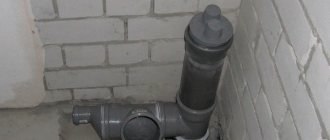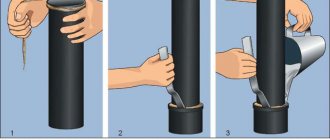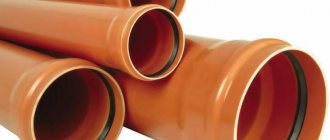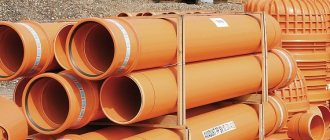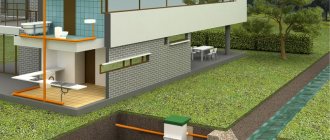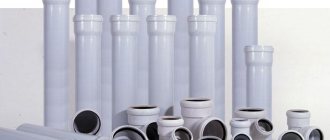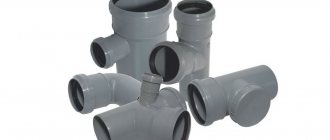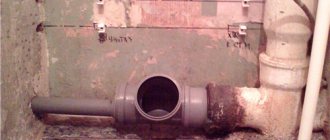The issue of arranging the sewer system of a private house is quite acute, because the cost of a mistake can be quite high. If there are deficiencies in the design and installation of sewage systems, there will always be an unpleasant odor inside the room, which brings not only discomfort, but also real harm to the health of household members.
When thinking through sewer system designs, many homeowners wonder what a drain pipe is and what its real use is. Professional plumbers answer this question unequivocally; they consider it an essential element of the septic tank, which they cannot do without. In this article we will tell you how to install a drain pipe and what its functions are.
What it is
When a private house is built, it is necessary to connect various communications to it. One of them is sewerage. At first glance, you might think that it is enough to equip it with only a sewer drain. In fact, this is not enough.
In order to explain the purpose of the vent riser, you need to remember how the toilet flushes in more detail. After the sewage is drained, a certain amount of water then gets there. Some of it remains in the toilet. It is actually a water seal, the role of which, in particular, is to prevent the unpleasant odor from the drains from entering the living quarters. It is important to understand that this protective layer of water is located inside the toilet.
If several such plumbing fixtures are installed in the house, then each of them, which is not currently in use, has such a water seal.
When one of the toilets is flushed, the pressure drops for a short period of time immediately after the sewage and drained water flows out. Since all the others are connected to this pipe, their water seals are broken and an unpleasant odor penetrates into the premises.
Diagram of the design and operation of the sewerage ventilation system Source profidom.com.ua
It is important to note that this situation exists not only in relation to toilets, but to all drains that are connected to the sewer system. For example, we can talk about a water seal in a bathroom or in a sink, if they are connected in the specified way.
This situation could have been avoided if the pipe had an additional outlet through which air could freely flow into it. In this case, low pressure would not arise at the drainage point and the water seals would not be broken anywhere.
Odors from the sewer could also escape through such a pipe. A sewer riser is a pipe that performs the specified functions, which is connected to the sewer system of the house and led outside it.
How necessary is it? In fact, the system in question is actively used in apartment buildings. In the sewer system, drainage from apartments occurs in a vertical pipe.
A system of vertical sewer pipes that performs the function of a drain riser Source ar.decorexpro.com
Its lower end is connected to the drainage system, and the upper end is brought out onto the roof and actually serves as a drain riser.
Technical requirements
The outlet pipe does not have any specific diameter requirements. Typically, a pipe similar to a sewer pipe is used for this purpose in apartment buildings.
Let’s assume that in a private house, a pipe with a diameter of 5 cm is used for drainage from the sink, the opening of the flush tank is 7 cm, and the pipe from the toilet is 10 cm. In this case, a drain pipe on the roof with a diameter of 10 cm can be used for the drain riser.
Practice confirms that such a pipe is sufficient to ensure constant pressure in the drainage system and to provide ventilation in it. If we are talking about a one-story private house in which only one toilet is installed, then here you can do without installing a vent riser.
Air supply and exhaust system Source gardeneer.me
This is due to the fact that the drain in this case will not be able to create a strong enough decrease in pressure so that unpleasant consequences can be felt.
However, in some cases, roof risers are necessary:
- If the house has at least two apartments with fully equipped sewerage systems, provided that they are connected to a common network.
- A sewer outlet to the roof for ventilation of the riser is required in a house with more than two floors .
- If there is an equipped horizontal sewer distribution system , provided that three or more plumbing fixtures are connected to it.
Fan exhaust pipe on the roof Source teplogidromash.ru
It is also necessary to provide:
- risers usually have a diameter of 10 cm, however, sometimes there are situations when a pipe with a diameter of 5 cm . Then the outlet of the vent pipe to the roof is mandatory .
- If the house has a swimming pool that discharges water into the sewer system , the use of the design in question is also necessary . This is due to the fact that in such a situation a large amount of water can be discharged.
- A vent riser and access to the roof are needed in cases where the drainage occurs into private septic tanks located next to the house .
- If the house is one-story , but the bathroom and toilet are located on different levels, and the drainage occurs in one pipe .
Fan pipe with outlet to the roof Source forumhouse.ru
See also: Catalog of companies that specialize in water supply and sewerage.
Fan pipe sizes
The length of the pipe can be completely different. An important parameter that in any case must be taken into account when choosing and installing a product is the diameter of the fan pipe.
It is recommended to select the diameter of the toilet drain pipe 40 mm larger than the drain diameter. Standard diameters for drain pipes are 50 and 70 mm. Fan products with diameters of 90 and 110 mm are ideal for these sizes. If you wish, you can choose an even larger part, but this does not make much sense.
The choice of such diameter indicators is due to the fact that the sewer substrate can create strong pressure and interfere with the normal operation of the structure. In this case, the wider the walls, the less chance that a powerful flow can damage the system. The cross-sectional size of the internal sewerage parts is smaller than the diameter of the drain pipe, and the external pipe is larger due to the fact that they carry wastewater from several risers and create higher pressure in them. The difference in size assigned the name “adapter” to the fan product.
Installation of vent pipes is required if:
- The number of storeys in the house exceeds 1 floor and there is a bathroom in the building;
- the structure is represented by 1 floor and includes 2 or more bathrooms;
- the house has 2 or more risers with a small diameter (50 mm);
- the presence of a jacuzzi or swimming pool;
- the drainage pit is too close to the residential building (8–10 m or closer).
For the fan riser, pipes of standard sizes are taken - 90 or 110 mm
Note! It is very important to remember that regardless of the type and characteristics of the sewer system (such systems can be gravity or forced), installation of a drain pipe is necessary when the slope of the sewer system is incorrect. Insufficient slope can cause improper operation of the sewer system and various accidents.
The fan structure, among other things, performs a soundproofing function. Thanks to her work, people living in the house do not hear the sounds of wastewater moving. This function is very important, because noise, especially in plastic pipes, can sometimes be very annoying
Carrying out installation
When installing a riser, it is important to pay attention to some points:
- There is no need to underestimate the diameter of the outlet pipe. If it is too narrow, then its thickness may not be enough for quality work. A pipe with a diameter of 100 mm is most suitable for this purpose.
- The horizontal part of the sewer system should not be located at the same level . In this case, there is a risk of water or air locks forming. It is recommended that the pipe be installed with a slight slope . It is usually considered sufficient to use a slope of two centimeters per meter of length for this purpose.
- Sometimes when installing the system, the riser is led not to the roof, but to the attic . This is strictly not recommended. Exposure to escaping air insulation to become saturated with moisture. Another consequence may be rotting of the rafters.
- a deflector is sometimes installed on its hole . It will protect against precipitation and random debris. Additionally, its effect in windy weather will be expressed in increased traction . But there is another opinion. It is believed that this or another additional device installed above the pipe opening contributes to the formation of condensation , which in frosty winter weather will lead to icing of the pipe from the inside. As a result, it will be partially clogged and may cease to perform its functions.
Example of an L-shaped fan pipe Source allremont59.ru
When carrying out installation, you need to consider:
- to move the sewer riser pipe away from the vertical sewer drain. If for some reason this is difficult to do, then the transition connection is best made using corrugated pipes.
- It is believed that the height of the pipe above the roof should be 50 cm . It is recommended to locate the roof exit at a distance of at least 4 meters from balconies or windows.
- The reliability of the system will be higher if you install a check valve. It is installed where the drainage into the public sewer pipe. Its effect is that drains from an apartment or house pass freely , and gases and liquids the opposite direction at all.
Check valve
Installing a check valve on the drain pipe can improve the efficiency of the system, in particular, prevent the backflow of gases. In addition, check valves reduce the risk of drain pipe clogging.
A sewer without a drain pipe equipped with a vacuum valve will perform its functions, however, the ease of use and reliability may be lower, so the combined use of these elements is still recommended. In particular, with dry water in the siphon, the valve alone will not get rid of the smell.
Valve on pipe
Installation of the drain pipe is carried out at the stage of construction of the internal part of the sewer system; it can be done with your own hands if you have minimal skills. It is only important to strictly follow the recommendations of specialists and the requirements of building codes and regulations. The use of modern materials significantly reduces the labor intensity of the work.
Is it necessary to put it on the roof?
Sometimes in apartment buildings, residents of the upper floor themselves dismantle the riser pipe leading upward.
Check valve operation diagram Source ufa-santehnik.ru
The motivation for this decision is insufficient knowledge of the principles of sewerage operation and the idea of a drain riser as something superfluous and unnecessary. Soon after this, a persistent smell from the sewer pipe appears on the upper floors.
The situation can be improved. In this case, there is no need to install vent pipes on the roof. It is enough to attach a special valve to it. It will not release air outside, but when a low pressure zone forms, it will let air in, which will prevent the water seals from breaking.
There is no need to put such a riser on the roof. The valve must be installed at the top of the sewer pipe system. Although this is convenient (there is no need to install a pipe passing through the roof), such a device is not highly reliable.
Vacuum valve for installation at the top of sewer pipes Source drive2.ru
Which pipe to choose
The material from which the pipe is made can be in the form of plastic or metal (cast iron). Metal is considered the most rational solution. They began to be installed back in the USSR. It is durable and practical. But it is very heavy, so there are significant problems with installation and repair.
Plastic is considered a popular material. It is cheap, flexible, the system is easy to install, and if it breaks, a piece of broken pipe can be easily replaced with a new casing. But they quickly fail, so you often have to call plumbers.
Complex equipment has appeared recently. If older homes have a cast iron system installed and it works flawlessly, but the new owner needs to attach plastic components. For this purpose, multitasking joints are used. But they should be selected exactly according to the diameter of the holes on both one side and the other.
In addition to the material from which the pipe is made, there are certain rules. These rules must be followed when installing equipment:
- The diameter of the hole in the drain pipe must be greater than or equal to the diameter of the riser. That is, it is prohibited to use a smaller diameter;
- The drain pipe should only be led to the roof so that it comes into contact with the atmosphere (at least 30 cm from the roof). It is prohibited to install the system near windows or on a balcony;
- One side (initial) should be in a warm place (i.e. a heated room), and the other end should go into a cold environment. Thus, a temperature difference arises, and the necessary pressure is created in the riser, and unnecessary odors will be removed from the room;
- It is recommended to install the ventilation branch and the riser from the same material.
Sometimes an unpleasant odor may appear in the room, although the entire system is installed correctly. This may be explained by the fact that the riser was selected with a small volume. And if you do not use the device for a long time (i.e. do not drain the water), the water pocket will dry out. The fan pipe saves the situation. Thanks to it, the air in the house will always be ventilated.
It may be interesting: How to independently eliminate noise and hum in a water supply pipe
Some tips
To install a fan riser, you should pay attention to the following:
- When bringing the pipe to the roof, you need to cover the hole with a grill . This is necessary to protect against birds.
- Sometimes when this system operates, a low, unpleasant noise . In order to get rid of it, you will need to wrap the pipe with a soundproofing coating.
- It is not always possible to bring from each to the roof . In this case, you can provide one pipe for several risers .
Options for exhaust pipe outlets Source td-intech.ru
Installation of a fan riser
Plastic or cast iron pipes can be used for this. There are several options for laying them. It can be straight, oblique or with a horizontal section. The first of these options is considered the most effective, but it cannot be implemented in all cases. Less suitable is the location of the fan pipe at an angle.
Options for laying the fan riser, pipe material and outlet openings vary Source sovet-ingenera.com
If it is not possible to carry out the installation using the previous methods, then you will have to use an installation where a horizontal section of the pipe will be used. It is laid within the attic from the point where it will be possible to install a vertical pipe.
The exhaust pipe exits to the roof using one of the following methods:
- It can be made in the form of a pipe on the roof .
- Sometimes it is done through the wall under the roof slope.
- Sometimes it happens that the outlet is located inside the attic .
The last option is of lower quality. At the same time, moisture escapes through the pipe, which can lead to condensation and rotting of the roof. In addition, sewer odors spread through the pipe. When it is located on the roof, this impact is minimized.
The second option is considered vulnerable to icing.
Valve system for a riser in the attic Source dretun.ru
In the attic, you can equip an exit from the riser only if you install a special valve there, which can only let air in, but not out.
Pipe materials and diameters
Since the drain pipe in a private house is part of the system, it would be optimal to make it from the same material that was chosen for the rest of the pipelines. In some cases, a combination of materials is allowed, but experts believe that the efficiency of dissimilar systems is significantly lower.
To install the internal part of the sewer system in a private house, cast iron or plastic pipes are used.
- Cast iron pipes have the required durability, but if they have defects during processing or receive mechanical damage, they become susceptible to corrosion. In addition, the large weight of the products significantly complicates installation, not only from the point of view of increasing labor costs, but also from the point of view of fixing vertical sections of the pipeline.
- Increasingly, plastic pipes , which, in addition to their low weight, also have a number of other advantages, including strength, durability, absolute immunity to corrosion and the presence of a smooth inner surface, which reduces the likelihood of the formation of deposits and blockages. Another advantage of plastic is a large selection of not only pipes of different diameters, but also the fittings necessary for the implementation of the developed scheme.
The choice of the diameter of the fan pipe is made taking into account the design features of the system. The main condition: the diameter of the drain pipe should not be less than the largest pipe (including pipes and bends) of the system.
Since in the vast majority of cases the largest sewer pipes are used to connect the toilet and have a diameter of 110 mm, the drain pipes are also installed with the same diameter.
